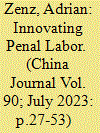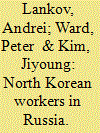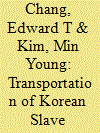|
|
|
Sort Order |
|
|
|
Items / Page
|
|
|
|
|
|
|
| Srl | Item |
| 1 |
ID:
190846


|
|
|
|
|
| Summary/Abstract |
We introduce a new dataset, Contemporary Slavery in Armed Conflict (CSAC), coding instances and types of enslavement in armed conflict from 1989 to 2016, building on Uppsala Conflict Data Program data. CSAC currently covers 171 armed conflicts from 1989 to 2016, with the unit of analysis being the conflict-year. We identify different types of enslavement within these conflicts and find that 87% contained incidences of child soldiers, 34% included sexual exploitation/forced marriage, 23% included forced labor, and 16% contained instances of human trafficking. The use of enslavement in armed conflict to support strategic aims is also identified and found in about 17% of cases. Next, drawing upon key variables from the Uppsala Conflict Data Program, we present a series of cross-tabulations looking at the presence of slavery and conflict broken down by conflict incompatibility, intensity level, and type. We see the coding of slavery within conflict as a step toward generating greater understanding of when and how state and non-state actors use enslavement within conflict, with the goal of mitigating and possibly eradicating slavery in warfare.
|
|
|
|
|
|
|
|
|
|
|
|
|
|
|
|
| 2 |
ID:
192598


|
|
|
|
|
| Summary/Abstract |
This article argues that China’s campaign of reeducation and forced labor in the Xinjiang Uyghur Autonomous Region through so-called Vocational Skills Education and Training Centers (VSETCs) represents a significant conceptual innovation over prior labor reform. Beijing’s erstwhile penal labor systems treated labor as an integral part of reeducation but suffered from limited reeducation results, low work productivity, and poor resocialization outcomes. In contrast, the VSETC system pragmatically eschews Maoist tenets of labor’s transformational power: its internment camps prioritize intensive reeducation, followed by a process of gradual release into potentially more efficient nonprison enterprises. The resulting potential profitability gains translate into higher economic sustainability—an essential prerequisite for the system’s primary goal of long-term assimilation and coercive integration of resistant ethnic groups into Beijing’s social order. However, VSETC’s and the region’s focus on control and disintegrating ethnic social capital undermines its integrative efforts, replicating a long-standing weakness of prior labor reform.
|
|
|
|
|
|
|
|
|
|
|
|
|
|
|
|
| 3 |
ID:
171001


|
|
|
|
|
| Summary/Abstract |
In recent years, North Korean workers overseas have begun to attract increasing attention of the international media, human rights activists, and academics. They are often depicted as being "modern-day slaves," but the present article challenges this approach. It relies on a number of sources, including interviews with former workers (currently residing outside North Korea) and their Russian employers. In many regards, overseas North Korean workers face problematic circumstances. Nonetheless, workers compete for the opportunity to go overseas, since the overseas work, in spite of all hardships, is much preferable to all jobs they can realistically have at home. Rather than seeing themselves as victims, more or less all our interviewees perceive themselves as active and entrepreneurial individuals who succeeded in securing work that, in spite of hard conditions, opens avenues for upward social mobility. They faced constraints and difficulties, of which they are all too aware, but also had agency to act within these constraints. We offer a critical examination of the "forced labor" claim and the applicability of the International Labour Organization's Forced Labour Convention to the issue.
|
|
|
|
|
|
|
|
|
|
|
|
|
|
|
|
| 4 |
ID:
078589


|
|
|
|
|
| Publication |
2007.
|
| Summary/Abstract |
Japan was more dependent upon ocean shipping than any other major power during World War II, and the sea route had been the only means of transportation between Korea and Japan. The connecting steamers contributed to Japan's wartime economy by transporting not only raw materials, but also forced laborers and sex slaves between Korea and Japan. More importantly, these connecting steamers were linked to railroads and land routes in Korea and were connected to various systems of transportation, including merchant ships and regular liners outside Japan. In this paper, we examine how Korean laborers and sex slaves were mobilized and transported from Korea to Japan during World War II by focusing on the interdependent relations between railroad-connecting ships and a travel agency
|
|
|
|
|
|
|
|
|
|
|
|
|
|
|
|
|
|
|
|
|